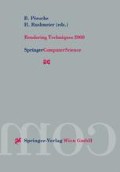Abstract
Tone mapping and visual adaptation are crucial for the generation of static, photorealistic images. A largely unexplored problem is the simulation of adaptation and its changes over time on the visual appearance of a scene. These changes are important in interactive applications, including walkthroughs or games, where effects such as dazzling, slow dark-adaptation, or more subtle effects of visual adaptation can greatly enhance the immersive impression. In applications such as driving simulators, these changes must be modeled in order to reproduce the visibility conditions of real-world situations. In this paper, we address the practical issues of interactive tone mapping and propose a simple model of visual adaptation. We describe a multi-pass interactive rendering method that computes the average luminance in a first pass and renders the scene with a tone mapping operator in the second pass. We also propose several extensions to the tone mapping operator of Ferwerda et al. [FPSG96]. We demonstrate our model for the display of global illumination solutions and for interactive walkthroughs.
Access this chapter
Tax calculation will be finalised at checkout
Purchases are for personal use only
Preview
Unable to display preview. Download preview PDF.
References
Adelson. Saturation and adaptation in the rod system. Vision Research, 22:1299, 1982.
Bäuml. Color constancy: the role of image surface in illuminant adjustment. JOSA A, 16(7): 1521, 1999.
R. Bracewell. Two-Dimensional Imaging. Prentice Hall, 1995.
Breneman. Corresponding chromaticities for different states of adaptation to complex visual fields. JOSA A, 4(6):115, 1987.
Brown. The world is not grey. Investigative Ophtalmology and Visual Sc., 35(Suppl.), 1994.
Chiu, Herf, Shirley, Swamy, Wang, and Zimmerman. Spatially nonuniform scaling functions for high contrast images. In Proc. Graphics Interface, 1993.
Durand and l. Dorsey. A computational model of visual adaptation for time-dependent tone-mapping, submitted for publication, 2000. http://graphics.lcs.mit.edu/~fredo.
D’Zmura and Lennie. Mechanisms of color constancy. JOSA A, 10:1662, 1986.
Fairchild. Color Appearance Models. Addison-Wesley, 1998.
Ferwerda. Fundamentals of spatial vision. In Applications of visual perception in computer graphics, 1998. Siggraph ‘98 Course Notes.
Jim Ferwerda and Sumant Pattanaik. personal communication, 2000.
Ferwerda, Pattanaik, Shirley, and Greenberg. A model of visual adaptation for realistic image synthesis. In Computer Graphics (Proc. Siggraph), 1996.
Fairchild and Reniff. Time course of chromatic adaptation for color-appearance judgments. JOSAA, 12(5):824, 1995.
Greenberg, Torrance, Shirley, Arvo, Ferwerda, Pattanaik, Lafortune, Walter, Foo, and Trumbore. A framework for realistic image synthesis. In Computer Graphics (Proc. Siggraph), 1997.
Hayhoe, Benimoff, and Hood. The time course of multiplicative and subtractive adaptation process. Vision Research, 27:1981, 1987.
Hood and Finkelstein. Sensitivity to light. In Boff, Kaufman, and Thomas, editors, Handbook of Perception and Human Performance. Wiley and Sons, 1986.
Hunt. Light and dark adaptation and the perception of color. JOSA A, 42(3): 190, 1952.
Hunt. The reproduction of Color (5th ed.). Kings Langley: Fountain Press, 1995.
Möller and Haines. Real-Time Rendering. A.K. Peters Ltd., 1999.
Millerson. Lighting for Television and Film, 3rd ed. Focal Press, 1991.
Nikon, http://www.nikon.ca, 2000.
Nakamae, Kaneda, Okamoto, and Nishita. A lighting model aiming at drive simulators. In Computer Graphics (Proc. Siggraph), 1990.
Neumann, Matkovic, Neumann, and Purgathofer. Incident light metering in computer graphics. Computer Graphics Forum, Dec. 1998.
Pattanaik, Ferwerda, Fairchild, and Greenberg. A multiscale model of adaptation and spatial vision for realistic image display. In Computer Graphics (Proc. Siggraph), 1998.
Pokorny and Smith. Colorimetry and color discrimination. In Boff, Kaufman, and Thomas, editors, Handbook of Perception and Human Performance. Wiley and Sons, 1986.
Pattanaik, Tumblin, Yee, and Greenberg. Time-dependent visual adaptation for realistic image display. In Computer Graphics (Proc. Siggraph), 2000. to appear.
Rohlf and Helman. IRIS performer: A high performance multiprocessing toolkit for real-Time 3D graphics. In Computer Graphics (Proc. Siggraph), 1994.
Schlick. Quantization techniques for visualization of high dynamic range pictures. Eurographics Workshop on Rendering, 1995.
Stokes, Fairchild, and Berns. Precision requirement for digital color reproduction. ACM Trans, on Graphics, 11:406, 1992.
Shaler. The relation between visual acuity and illumination. J. of General Physiology, 21:165, 1937.
Scheel, Stamminger, and Seidel. Tone reproduction for interactive walkthroughs. In Proc. of Eurographics, 2000. to appear.
Spencer, Shirley, Zimmerman, and Greenberg. Physically-based glare effects for digital images. In Computer Graphics (Proc. Siggraph), 1995.
Tumblin, Hodgins, and Guenter. Two methods for display of high contrast images. ACM Trans, on Graphics, 18(1), January 1999.
Tumblin and Rushmeier. Tone reproduction for realistic images. IEEE Computer Graphics and Applications, 13(6), 1993.
P. W. Trezona. Rod participation in the “blue” mechanism and its effect on colour matching. Vision Research, 10:317, 1970.
Tumblin and Turk. LCIS: a boundary hierarchy for detail-preserving contrast reduction. In Computer Graphics (Proc. Siggraph), 1999.
Tumblin. Three methods of detail-preserving contrast reduction for displayed images. PhD thesis, College of Computing Georgia Inst, of Technology, Sep. 1999.
Ward. A contrast-based scalefactor for luminance display. In l. Heckbert, editor, Graphics Gems IV, page 415. Academic Press, 1994.
Walraven, Enroth-Cugell, Hood andMacLeod, and Schnapf. The control of visual sensitivity. In l. Spillmann and Werner, editors, Visual Perception, The neurophysio-logical foundation. Academic Press, 1990.
Ward-Larson, Rushmeier, and Piatko. A Visibility Matching Tone Reproduction Operator for High Dynamic Range Scenes. IEEE Trans, on Visualization and Computer Graphics, 3(4), 1997.
Wyszecki and Stiles. Color Science: Concepts and Methods, Quantitative Data and Formulae. Wiley, 1982.
Walraven and Valeton. Visual adaptation and response saturation. In A. J. van Doom, W. A. Van de Grind, and J.J. Koenderink, editors, Limits in Perception. VNU Science Press, 1984.
Author information
Authors and Affiliations
Editor information
Editors and Affiliations
Rights and permissions
Copyright information
© 2000 Springer-Verlag Wien
About this paper
Cite this paper
Durand, F., Dorsey, J. (2000). Interactive Tone Mapping. In: Péroche, B., Rushmeier, H. (eds) Rendering Techniques 2000. EGSR 2000. Eurographics. Springer, Vienna. https://doi.org/10.1007/978-3-7091-6303-0_20
Download citation
DOI: https://doi.org/10.1007/978-3-7091-6303-0_20
Published:
Publisher Name: Springer, Vienna
Print ISBN: 978-3-211-83535-7
Online ISBN: 978-3-7091-6303-0
eBook Packages: Springer Book Archive

